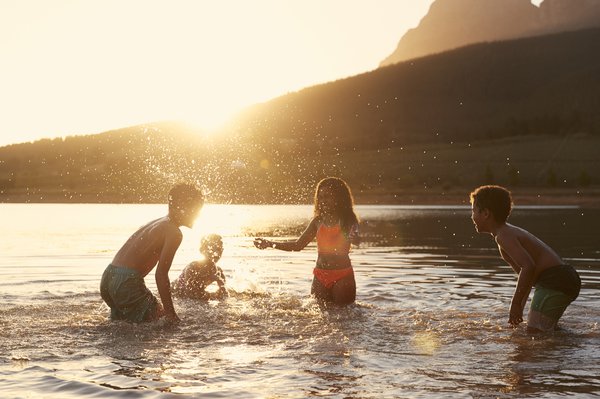We all know the best way to protect our children from the sun’s damaging rays is to limit their exposure. But sometimes, that’s easier said than done. (Have you ever tried to put sunscreen on a toddler?) For that reason, many dermatologists recommend a multi-pronged approach: sunscreen, shade, and protective clothing to ensure maximum coverage.
Sunscreen 101
Besides staying out of the sun entirely (which, as any parent will tell you, is entirely unrealistic when you have children of any age), the best way to protect your kids from the sun is to slather them in sunscreen. But before you douse your kids from head to toe, there are a few tips to keep in mind when you’re wrangling your crocodile, err, 2-year-old.
- Apply sunscreen 30 minutes before your child goes outside. If you think it’s difficult to apply sunscreen to your child at home, it’s about ten times worse when you are already at the beach/park/playground, there’s sand or dirt everywhere, and all your child wants to do is play.
- Use a broad-spectrum, water-resistant sunscreen that is SPF (Sun Protection Factor) 30 or higher. Broad-spectrum sunscreen is important because it protects against both UVA and UVB rays. And trust me, you don’t want a cranky, sunburned child.
- Make sure you are covering often-overlooked spots such as ears, scalp, tops of feet, back of neck, shoulders, and backs of hands. Don’t forget lips, too, which can be protected by lip balms that contain SPF. If it’s not covered by clothing or a hat, make sure to cover it with SPF.
- Reapply sunscreen every two to three hours, or after sweating or swimming.
- Avoid spray sunscreens. They don’t protect your kids from the sun very well because their coverage is spotty, and they can easily be inhaled. Stick sunscreens can be used but you need about four passes on each area of skin to be fully effective.
- The best sunscreens for kids are mineral-based sunscreens (technically called “sunblocks”) which sit on the surface of your skin and create a physical barrier that blocks UV rays and prevents them from entering the skin. These are recommended by dermatologists because they do not contain potential hormone disruptors. The most active ingredients in mineral sunscreens are usually zinc oxide or titanium dioxide, and they are often free of many irritating or harmful chemicals such as parabens, phthalates, fragrances, and dyes.
- Squirmy kid? Make a game out of it. Tell your kid to put out their “airplane arms,” play “Simon says,” or even sing a song. Whatever works!
- Ideally you should be using sunscreen every day, so in theory, you shouldn’t have last summer’s bottle of sunscreen sitting around when it’s time to head to the beach this summer. If you are wondering about expiration dates, the FDA requires that all sunscreens retain their original strength for at least three years.
- Since sunscreens are not recommended for babies under six months of age, the American Academy of Dermatology and the Skin Cancer Foundation advise keeping your infant out of the sun entirely. Make sure they are in shade or under an umbrella. If they have to be exposed to the sun, dress them in lightweight long sleeves and pants, a hat with a wide brim, and sunglasses.
Beyond SPF: Other ways to protect your kids from the sun
- Stick to the shade during peak sun exposure . The sun is usually strongest between 10 a.m. and 2 p.m. If your kids are outside during this time, apply and reapply sunscreen — even if they’re just playing in the yard. It’s important to remember that most sun damage happens during everyday activities, not from being at the beach or on vacation. This is especially true on cloudy days. Children can get skin damage even when it’s cloudy, overcast, or cool. Make sure you protect your kids from the sun (even if you can’t see the sun) whenever they’re outside.
- Invest in some sun-blocking rash guards. The easiest way to protect your kids from the sun and reduce the amount of kid-wrangling you have to do is to cover as much as surface area you can. That’s why I love rash guards for myself and my children. The long-sleeved spandex swim shirts cover more skin, which translates to less skin that I have to cover with sunscreen — a win for parents everywhere.
- If your child will keep them on, hats and sunglasses are no-brainers. The scalp is especially prone to the sun’s rays and eyes are also susceptible to sun damage. There are a variety of UPF 50+ hats with extra wide brims and neck coverage that are perfect for children on-the-go. If your kid won’t wear a hat, try wearing a hat yourself. Oftentimes, this can encourage your kid to wear one.
- Invest in an umbrella, canopy, or beach tent. For non-mobile babies, beach tents and umbrellas can be lifesavers. For active, more older kids, there are larger beach canopies that allow more movement under shade. Children go to where the fun is, so if you set up a play area under a canopy (perhaps with a blow-up kiddie pool and sand toys?), you can protect your kids from the sun while still bringing the fun.
This article was originally published on IBX Insights.
About Sarah Bishop
I’m a writer and bookworm who loves learning and writing about the latest health and wellness topics. Like a true Gemini, I’m a walking dichotomy. I like kale, broccoli, and Brussels sprouts, but I also like ice cream, fried chicken, and cheese. So, I’m always fighting the good fight. As the mom of two little girls, I strive to model healthy habits that my daughters will carry with them for life.



